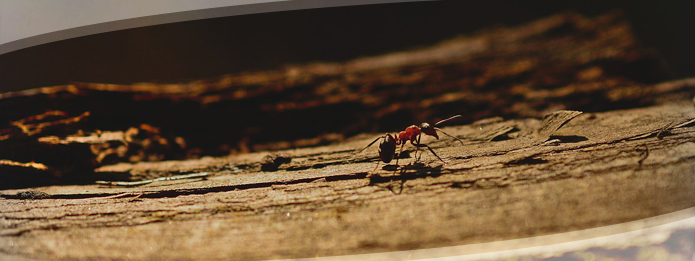What Does A Carpenter Ant Look like?

Many insects are very small to the human eye and can be easily mistaken for other pests if you don’t know what to look for. It is important to know what your dealing with if you have a pest problem so that the right pest control plan can be implemented. The most common type of carpenter ant in Canada is the red and black. They are either dark brown or black in colour. They have a very thin waist between the upper and lower body with a bent antenna as well. The adult male and female have wings during mating time.
Carpenter ants dig and tunnel through wood to make their nests and the most common place to build is outdoors. They can cause significant structural damage to your home when they build their nests on roofs and in woodwork close to moist sources. Carpenter ants live in colonies and have a complex social structure and class system. The queen is the head of the colony. Therefore, any successful pest control treatment for carpenter ant is eliminating the queen.
How to spot the Queen
There are thousands of ants in a colony but usually only one queen. It is very rare to spot the queen because she stays hidden in the nest protected by the worker ants. The queen is much bigger than the other ants in the colony, measuring up to an inch long.
Winged males and females participate in swarms where they fly along and mate. The males die after mating while the females shed their wings and look for an appropriate nesting place. A queen usually has a brood of 15 to 20 eggs, which she feeds entirely on her own.
The queen raises her first brood by feeding them with stored fat and her wing muscles. It takes between 6 to 12 weeks for the development of eggs to adult workers. This first batch becomes the workers of the colony. Their duty is to forage food and take care of the young ants and the queen. The queen’s only purpose is to lay eggs.
The first generation of workers is usually smaller in size because they were fed solely from the body fluids of the queen. The next generations, however, grow bigger because of foraging on a diet consisting of insects and sugars.
It takes at least two years for the queen to produce winged swarmers, which form new colonies. The life span of the queen is about 25 years, and during her lifespan, she lays thousands of fertilized eggs. Any pest control treatment should focus on removing the queen.
Colonies
Carpenter ants are difficult to control due to the way they nest and create colonies. These ants establish two main types of nests; the parent and the satellite. The parent nest consists of the queen, eggs and small larvae. The satellite nests have larger larvae and pupae. Decaying wood close to sources of moisture is among the favourite sites for parent colonies, while satellite colonies prefer drier places.
Carpenter ants found inside homes are usually a satellite colony. They established sites in several locations such as attic insulation, hollow doors, and small cavities around the home.
The ants you see are usually workers searching for food. They are mostly active at night and can cover a distance of 100 feet from their nests in search of food.
Calling the Experts for Your Ant Problem
You can control carpenter ant infestations in your home by removing dead trees and limbs near to foundation and by storing firewood elsewhere. Where you have dead tree limbs and trunks, remove these as they can become nesting sites. Fix leaking roofs and plumbing and examine crawl spaces for extra moisture. Don’t allow rain gutters to flow towards your house.
For effective carpenter ant control, you’ll need the services of a professional. Trained technicians will be able to find the parent nest and remove the queen. After that, they can work through the rest of your home to ensure any further colonies are also removed. Not only will pest control experts remove any existing ant colonies from your home, but they will also protect your home from any future infestations.